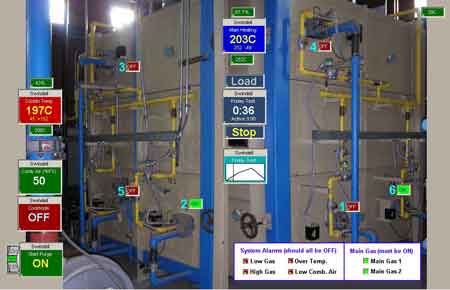- Home
- Products & Applications
- Supervisory System
- Build Or Buy?
- Pulsed Combustion
- Tunnel Kilns
- Periodic Kiln Construction
- Firing Curves
- Screen shots
- Ram Control
- How To Order
- Version History
- Downloads
- Kiltel Tech Notes
- Kiltel Program Files
(password required) - Customers
- Compatible Suppliers
- Contact Kiltel
A shuttle kiln photo has been decorated with status displays showing the dynamic values for process variables, as well as override switches for kiln events. Any photo, drawing or graphic can be used as a screen background, and any number of screens can be added at any time, while the program is running and without requiring any programming.
The photo shows the tunnel kiln at the Hanson Brick Co. plant in Mooringsport, LA. The kiln was converted to pulsed combustion using the Kiltel supervisory system, retaining the original NA Tempest burners and with new air and gas manifolds.
The photo shows the tunnel kiln at the Hanson Brick Co. plant in Athens, TX. The kiln was converted to pulsed combustion using the Kiltel supervisory system, retaining the original NA Tempest burners and with new air and gas manifolds. For this kiln pairs of burners were fed with shared drops from the air manifold. The kiln was sealed with Gunite as part of the rebuild.
This simple schematic (created with MS Paint) shows a 10-burner pulsed shuttle kiln. The kiln has been divided into 4 zones, each roughly corresponding to the position of the 4-car load, so that cars can be loaded with highly non-uniform ware and mass distribution.
This highly elaborate screen, created by the customer using CorelDraw, shows the process variables and pulsed burner status for a tunnel kiln used for high-fire alumina products.
This screen has been composed from a mashup of the two sides of a Swindell-Dressler shuttle kiln at the National Brick Research Center at Clemson University. Safety-train status indicators and pulsed burner firing status are shown, together with the runclock and single-zone control temperature.
This screen shows the beginning section of a large Harrop tunnel kiln at Pine Hall Brick Co. in Madison, NC. Crown thermocouples and kiln draft pressure sensor locations are shown, as well as the safety train status.
The photo shows a Miller Cross-Flow kiln dating from the 1950s, at LaChance Brick in Gorham, Maine. Kiltel provided a total rebuild for this kiln (note the rebricked burner arches) and replaced the original oil burners with a gas-fired system using pulsed-combustion with Hauck SVG burners, including new air and gas manifolds and flashing control.










